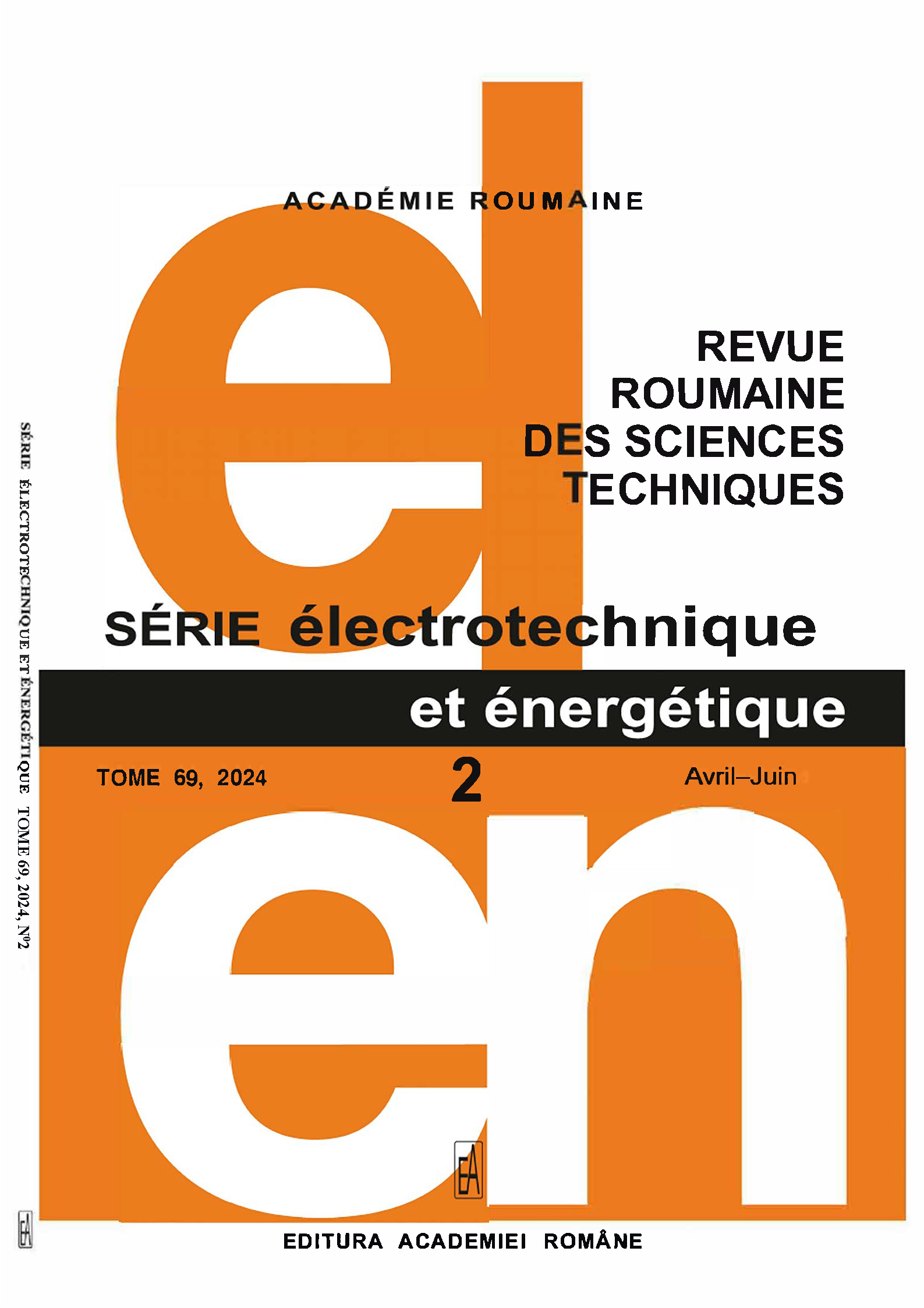CONTRÔLE DIRECT DU COUPLE AVEC MODULATION VECTORIELLE SPATIALE UTILISANT DES RÉGULATEURS À LOGIQUE FLUUSE DE TYPE 2 À INTERVALLE D'UNE MACHINE À INDUCTION À DOUBLE ÉTOILE ALIMENTÉE PAR DEUX ONDULEURS À POINT NEUTRE À TROIS NIVEAUX SERRÉS
DOI :
https://doi.org/10.59277/RRST-EE.2024.2.7Mots-clés :
Machine à induction double étoile (DSIM), Onduleur à point neutre à trois niveaux, Régulateur à logique floue de type 2 à intervalle (IT2FLC), Contrôle direct du couple avec modulation vectorielle spatiale (DTC-SVM)Résumé
Cet article présente une méthode de contrôle direct du couple (DTC) avec modulation vectorielle spatiale (SVM) utilisant des régulateurs à logique floue de type 2 à intervalle pour une machine à induction à double étoile alimentée par deux onduleurs à point neutre à trois niveaux. Le variateur DTC conventionnel utilise une paire de comparateurs à hystérésis, ce qui peut entraîner des problèmes tels qu'une ondulation de couple élevée et une fréquence de commutation variable. En conséquence, nous introduisons plusieurs méthodes alternatives, notamment DTC-SVM. Nous remplaçons les comparateurs d'hystérésis par deux régulateurs proportionnels-intégraux (PI) pour améliorer les performances du DTC, qui génèrent les composantes de tension continue et en quadrature dans la trame dq. La complexité du système de contrôle peut rendre difficile le réglage des paramètres du régulateur PI. Pour relever ce défi, nous proposons d'utiliser un régulateur à logique floue de type 2 à intervalle pour l'ajustement des paramètres PI dans cet article. Nos résultats de simulation démontrent la robustesse et l’efficacité du régulateur IT2FLC.
Références
(1) R. Anagha, M. Soman, M. Holmukhe, Double stator induction machine for variable speed and variable torque applications, SSRG International Journal of Electrical and Electronics Engineering, 8, 12, pp. 1 (2021).
(2) R. Belal, M. Flitti, M.L. Zegai, Tunning of PI speed controller in direct torque control of dual star induction motor based on genetic algorithms and neuro-fuzzy schemes, Rev. Roum. Sci. Techn. Electrotechn. EtEnerg. 69, 1, pp. 9–14, Bucarest (2024).
(3) M.I. Abdelwanis, A.A. Zaky, Maximum power point tracking in a perovskite solar pumping system with a six-phase induction motor Rev. Roum. Sci. Techn. Electrotechn. EtEnerg. 69, 1, pp. 15–20, Bucarest (2024).
(4) M. Hojat, A.S- Mohammad, Controlling the speed and flux of a dual stator winding induction motor using anemotional intelligent controller and integration algorithm, Turk J Elec Eng& Comp Sci, 26, pp: 3192–3206. (2018).
(5) L. Hellali, S. Belhamdi, Performances of type 2 fuzzy logic control based on direct torque control for double star induction machine. Rev. Roum. Sci. Techn. Electrotechn. EtEnerg., 65, 1-2, pp: 103–108, Bucarest (2020).
(6) Ehsan Hassankhan, and Davood A. Khaburi, DTC-SVM scheme for induction motors fed with a three-level inverter, World Academy of Science, Engineering and Technology, 44 (2008)
(7) B. Abdelmalik, S. Saad, A. Abdelhak, L. Yahia, A study of SVM-DTC and conventional DTC for induction motors drive fed by five-level inverter, European Journal of Electrical Engineering, 21, 1, pp. 85-96 (2019).
(8) L. Hellali, S. Belhamdi, L. Benyettou. DTC-SVM based on interval type-2 fuzzy logic controller of double stator induction machine fed by six-phase inverter, International Journal of Image, Graphics and Signal Processing (IJIGSP), 11, 7, pp.: 48-57 (2019)
(9) H. Reghioui, S. Belhamdi, A. Abdelkarim, Enhancement of space vector modulation based-direct torque control using Fuzzy PIController for doubly star induction, Motor Advances in Modelling and Analysis C. 74, 2-4, pp. 63-74 (2019)
(10) A. Meroufel, S. Massoum, A. Bentaallah, P. Wira, F. Belaimeche, A. Massoum, Double star induction motor direct torque control with fuzzy sliding mode speed controller, Rev. Roum. Sci. Techn. Electrotechn. EtEnerg., 1, pp.:31–35 (2017)
(11) D. Lalili, E. M.Berkouk, F.Boudjema, N. Lourci, T.Taleb, J. Petzold. Simplified space vector PWM algorithm for three-level inverter with neutral point potential control, The Mediterranean Journal of Measurement and Control, 3, 1, pp.: 30-39. (2007)
(12) E. Benyoussef, A. Meroufel, S. Barkat, Three-level direct torque control based on artificial neural network of double star synchronous machine, Leonardo Journal of Sciences, 13, 24, pp.: 15-27 (2014).
(13) R. Sadouni, Three level DTC SVM for dual star induction motor fed by TowCascade VSI with DPCVF SVM, Rectifier Journal of Power Technologies, 100, 2, pp.: 171-177 (2020)
(14) F. Berrabah, S. Salah, A. Chebabhi SVM technique based on DTC sensorless control optimized by ANN applied to a double stator asynchronous machine fed by three level six-phase inverter, The Mediterranean Journal of Measurement and Control, 12, 2, pp.: 571-579 (2016).
(15) E. Monmasson, J.P. Louis Presentation of a control law for IM drive based on the dynamic reconfiguration of a DTC algorithm and a SVM-DTC algorithm, Electric Power systems Research 63, pp.:321-333 (2003).
(16) T.G. Motorola, F. Habetler, F. Profumo, M.Pastorelli, L. Tolbert. Direct torque control of induction machines using space vector modulation, IEEE Transaction on Industry Applications, 28, 5, pp.: 1045-1053 (1992)
(17) J.M. Mendel. Advances in type-2 fuzzy sets and systems, Information Sciences, 177, pp.:84-110 (2007)
(18) I. Hamdan, M.M.M. Youssef, O. Noureldeen, Influence of interval type-2 fuzzy control approach for a grid-interconnected doubly - fed induction generator driven by wind energy turbines in variable-speed system, SN Appl. Sci., 5, 25 (2023).
Téléchargements
Publiée
Numéro
Rubrique
Licence
(c) Copyright REVUE ROUMAINE DES SCIENCES TECHNIQUES — SÉRIE ÉLECTROTECHNIQUE ET ÉNERGÉTIQUE 2024

Ce travail est disponible sous licence Creative Commons Attribution - Pas d'Utilisation Commerciale - Pas de Modification 4.0 International.


